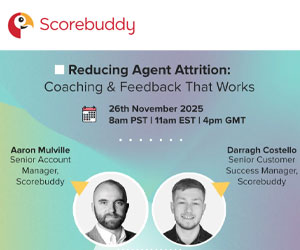Dick Bourke of Scorebuddy shares his keys to measuring and improving contact centre performance.
Worldwide, only 67% of people believe that customer service, as a whole, is improving – according to Microsoft. This emphasises that customer service expectations are higher than ever.
However, it’s becoming increasingly difficult for call centres to meet those customer expectations. That’s why it’s never been more critical to improve your call centre performance.
Also, according to Bain & Company, a customer experience promoter has a lifetime value to a company that’s 600 to 1400% of that of a detractor, but developing promoters is not an easy task.
It takes consistent work to improve call centre management for optimised performance, and there are four steps to help you get there.
Measure and Track the Right Data to Optimise Call Centre Performance
The first step to optimising your call centre performance is to measure and track your progress. It’s essential that you quantitatively and qualitatively measure key performance indicators (KPIs) that can help fine-tune your efforts.
Your end goal should be to set milestones and track your momentum toward those milestones based on specific data points. The key is making sure you’re measuring the right data if you want to positively impact your call centre performance.
To help you get started, we’ve outlined some of the most significant call centre metrics below which impact performance.
1. Average Speed to Answer
This is the amount of time it takes for your call centre agents to answer a call. The lower the number, the better.
2. First Call Resolution Rate (FCR)
Customers who are satisfied during their first interaction with your business are more likely to become loyal customers and have a positive customer experience.
Your first call resolution rate illustrates how often a customer’s queries are satisfied during the first call.
3. Customer Satisfaction Rating (CSR)
CSR is typically a five-point scale with one being “very dissatisfied” and five being “very satisfied”. This critical metric tells your call centre agents how effectively they’ve helped a customer.
4. Auxiliary Time
This metric tells you how often an agent is unavailable to make or answer calls. The key is to set clear parameters and definitions for auxiliary time, so you know if your metric falls within or outside accepted standards.
5. Schedule Adherence
Are your agents doing the work they’re scheduled to do? Schedule adherence helps ensure your agents are productive, good at managing their time, and can effectively streamline tasks.
6. Number of Calls Until Resolution
This metric is as important to track as FCR, and can highlight how often you have repeat callers and the time it takes to finally resolve the issue.
According to SQM, customer satisfaction drops by 15% every time a customer has to call back about the same issue.
7. Active & Waiting Calls
These two metrics equate to the total amount of active calls and total number of callers sitting on hold. This tells you how busy your call centre is and the length of wait to help those customers. You’ll also want to track how long customers are kept on hold.
Invest in the Right QA Software
To help track all of these call centre metrics, you’ll want to invest in QA software that makes it easy to assess calls, track non-traditional metrics, and manage your entire call centre from a 360° perspective.
The software should be easy to engage with agents and showcase the benefits of collaboration, transparency, and communication.
Also, it should enable you to make impactful, measurable changes in the call centre which consistently focuses on improving call centre performance.
The right QA software doesn’t just collect data; it helps you make sense of that data. It should highlight agent patterns and trends while helping you drill down into groups, teams, or into individual agent levels.
These tools should be able to compare performances between agents over time to highlight training gaps, so you’re consistently monitoring and implementing steps to improve quality.
Use Scorecards
Scorecards are one of the most valuable tools in your arsenal for monitoring your call centre performance and finding new ways to enhance customer experience.
When you implement agent scorecards, you give your company a way to assess every agent and customer interaction to ensure customer satisfaction.
The first step to a successful call centre scorecard system is defining your criteria. For example, you might consider scoring an agent’s problem-solving capabilities, compliance adherence, soft-skills, etiquette, script compliance, and follow-up skills.
Use your scorecard criteria to align with your KPIs, but keep it condensed to just 10 to 20 questions. Design the scorecard so that it is easy to interpret and it produces actionable insights instead of it resulting in an unnecessary exercise.
Finally, launch your new scorecard across your call centre and prepare to collect and analyse the results regularly. The goal of the scorecard should be to identify your agent and call centre strengths and weaknesses in order to make corrections as needed.
Invest in Training
In the end, you want to empower your call centre agents for success, and that means ongoing training. Utilise your data, QA software, and scorecards to produce a program that consistently reviews agent performance and provides insights, feedback and training on areas which require improvement.
Another benefit of agent training is a better understanding of your talent pool. The skills of each agent should quickly become evident, and that’s valuable information for call routing.
Once you realise where each agent excels, you can then route calls to the best agent for those particular cases. This will ensure a higher FCR, greater customer satisfaction, and moreover happier employees.
Ultimately, training is how you will implement all the necessary changes to improve call centre performance and customer satisfaction rates.
Knowledge Is Power (& How You Optimise Call Centre Performance)

Dick Bourke
You can’t know where you’re headed without first knowing where you’re at. The same goes for improving call centre performance. Tracking, measuring, and analysing the right call centre metrics is essential to optimising your performance.
The good news is that with the right preparation, QA software, scorecards, and agent training, you can improve every aspect of your call centre.
This blog post has been re-published by kind permission of Scorebuddy – View the Original Article
For more information about Scorebuddy - visit the Scorebuddy Website
Call Centre Helper is not responsible for the content of these guest blog posts. The opinions expressed in this article are those of the author, and do not necessarily reflect those of Call Centre Helper.
Author: Scorebuddy
Published On: 11th Jun 2019 - Last modified: 18th Jun 2019
Read more about - Guest Blogs, Scorebuddy






 Scorebuddy is quality assurance solution for scoring customer service calls, emails and web chat. It is a dedicated, stand-alone staff scoring system based in the cloud, requiring no integration.
Scorebuddy is quality assurance solution for scoring customer service calls, emails and web chat. It is a dedicated, stand-alone staff scoring system based in the cloud, requiring no integration. 































